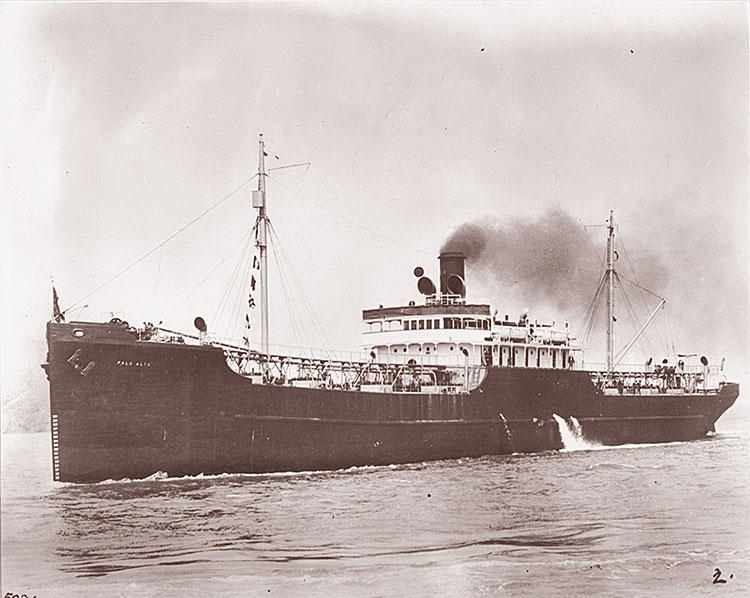
And in Aptos, we have the Cement Ship. If we had to pick a mascot for our town, it would be the Cement Ship. Although there are many wonderful and beautiful reasons to love Aptos, I think it is safe to say the Cement Ship is what most people think of when they think of Aptos.
She has played an integral part in the identity of Aptos ever since her arrival in 1930. Her story, however, actually begins in 1918 when the United States Shipping Board had announced that it would build a fleet of thirty-eight 7,500-ton concrete ships.
As it turns out, only eight of these ships were actually completed. The SS Palo Alto (more commonly known in Aptos as the Cement Ship) was the first to be launched on May 29, 1919, which makes this a very special year. This is the year we celebrate her 100th birthday!
But lets face it, Cement Ship rolls off the tongue much better than Concrete Ship, and since I grew up calling her the Cement Ship, that is how I still refer to her today.
The U.S. had declared war on Germany in 1917 and WW1 was in full effect when the order for these concrete ships was made. Why concrete you may be wondering? Seems counterintuitive to build something you want to float on water out of something that normally sinks right?
Early on, most ships were built of wood until steel ships all but replaced them. But war rations had greatly reduced the stockpiles of steel and recent attempts at building concrete ships had proven successful. The cost, stability, ease of repair, immunity to fire and corrosion, insulation, and cleanliness were all benefits of a cement ship so the order was placed.
Fortunately for the world, the war ended on November 11, 1918, when Armistice was signed. Unfortunately for the ships, the demand for concrete ships had all but disappeared and before they were even finished, they were no longer needed.
However, as I mentioned, eight of these concrete ships were built to completion, the Palo Alto being one of them. She was built by the SF Shipbuilding Company at the US Navel Shipyard on Government Island, which is in the harbor between Oakland and Alameda.
Measuring in at 435 feet, she cost an estimated $1.5 million to build with a 2,800 horsepower steam engine, bronze fittings, an eleven ton bronze propeller fifteen feet in diameter, a fifteen-ton rudder, decks of white Norwegian ash, and a tile-floored gallery.
She had fourteen watertight oil compartments with a total carrying capacity of 3 million gallons. Today’s supertankers hold an average of 84 million gallons but for her day, the Palo Alto was a sizeable ship.
Due to her size, she had to be launched sideways. So at 2:15pm, on May 29, 1919, Mrs. Anna May Wig shattered a bottle of champagne against her bow, and the Palo Alto slid to starboard down the wooden ways into the water creating a sizable wave in the harbor!
She was commissioned in October 1920, and lay at anchor, virtually discarded in Oakland and Benicia for the next four years. Her only voyage under her own power took place on January 2, 1921, when she sailed across San Francisco Bay to the Hunter’s Point dry dock.
There was an offer to purchase the Palo Alto and her sister-ship the Peralta by a man who wanted to sink them for breakwater. The offer was declined because both ships were new, seaworthy, and at least suitable for oil storage. The Shipping Board finally sold her on December 22, 1924, at the surplus-scrap price of $18,750 to the Oliver Olson Company.
Although Olson had intended on using her for oil storage, the market never materialized and the Palo Alto was towed to the Moore Shipbuilding Company in Oakland.
Next month my article will look at her journey to Aptos and her glory days as an “Entertainment Ship.”
The Aptos History Museum has teamed up with State Parks and other community volunteers to plan a very special series of events to celebrate this occasion, including a history presentation at the Rio Sands Hotel on May 18th, a musical performance on May 19th at Cabrillo, and a party on June 1st at the Seacliff Visitor Center. More details to come!
•••
For more information about the Aptos History Museum, upcoming events, or becoming a member of the museum, please visit www.aptoshistory.org and follow us on Facebook and Instagram @aptos_history_museum.